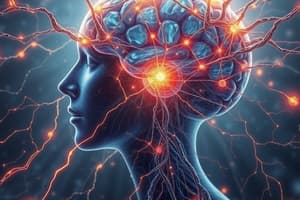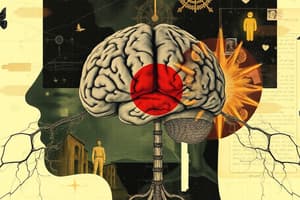Podcast
Questions and Answers
What function does the central nervous system (CNS) primarily serve?
What function does the central nervous system (CNS) primarily serve?
- Processing information and issuing commands (correct)
- Regulating hormonal balance in the body
- Transmitting sensory information to the body
- Connecting the brain to limbs and organs
Which characteristic of the nervous system describes its connection and teamwork among millions of nerve cells?
Which characteristic of the nervous system describes its connection and teamwork among millions of nerve cells?
- Adaptability
- Complexity (correct)
- Electrochemical transmission
- Plasticity
What is the primary role of afferent nerves in the nervous system?
What is the primary role of afferent nerves in the nervous system?
- To carry information to the brain (correct)
- To transmit pain signals
- To regulate emotional responses
- To control muscle movements
What term best describes the brain's ability to change physically in response to new experiences?
What term best describes the brain's ability to change physically in response to new experiences?
What system connects the central nervous system to the rest of the body?
What system connects the central nervous system to the rest of the body?
How do nerves in the nervous system chiefly communicate?
How do nerves in the nervous system chiefly communicate?
What does the term 'integration' imply about the nervous system's functionality?
What does the term 'integration' imply about the nervous system's functionality?
Which of the following best describes the role of efferent nerves?
Which of the following best describes the role of efferent nerves?
What type of scan provides information about brain activity and is often used to help diagnose Alzheimer’s disease?
What type of scan provides information about brain activity and is often used to help diagnose Alzheimer’s disease?
Which component of the brain is primarily responsible for regulating involuntary functions such as breathing and heart rate?
Which component of the brain is primarily responsible for regulating involuntary functions such as breathing and heart rate?
Which imaging technique provides a three-dimensional X-ray image to assess brain structure?
Which imaging technique provides a three-dimensional X-ray image to assess brain structure?
What is the primary function of the cerebellum?
What is the primary function of the cerebellum?
Which brain imaging technique measures changes in blood oxygen levels to assess both brain structure and activity?
Which brain imaging technique measures changes in blood oxygen levels to assess both brain structure and activity?
What occurs during the action potential phase of a neuron?
What occurs during the action potential phase of a neuron?
Which statement correctly describes the resting potential of a neuron?
Which statement correctly describes the resting potential of a neuron?
What is the ALL-OR-NOTHING principle in the context of action potential?
What is the ALL-OR-NOTHING principle in the context of action potential?
What is the primary role of neurotransmitters?
What is the primary role of neurotransmitters?
What happens after a neuron fires an action potential?
What happens after a neuron fires an action potential?
What role does the substantia nigra play in the midbrain?
What role does the substantia nigra play in the midbrain?
Which structure in the limbic system is primarily involved in memory storage?
Which structure in the limbic system is primarily involved in memory storage?
What is a primary function of the thalamus in the forebrain?
What is a primary function of the thalamus in the forebrain?
Which part of the cerebral cortex is involved in language processing and memory?
Which part of the cerebral cortex is involved in language processing and memory?
What behaviors does the reticular formation primarily influence?
What behaviors does the reticular formation primarily influence?
Which structure monitors drinking, eating, and sexual behavior?
Which structure monitors drinking, eating, and sexual behavior?
What is the function of the basal ganglia?
What is the function of the basal ganglia?
What critical role does the amygdala play in the limbic system?
What critical role does the amygdala play in the limbic system?
What is the term for the process by which healthy neurons grow new branches next to damaged cells?
What is the term for the process by which healthy neurons grow new branches next to damaged cells?
What does a genome-wide association method primarily involve?
What does a genome-wide association method primarily involve?
Which type of stress is characterized by a prolonged state that may lead to negative health outcomes?
Which type of stress is characterized by a prolonged state that may lead to negative health outcomes?
Gregor Mendel's work in the mid nineteenth century primarily focused on what aspect of genetics?
Gregor Mendel's work in the mid nineteenth century primarily focused on what aspect of genetics?
What does the term phenotype refer to in genetics?
What does the term phenotype refer to in genetics?
What process involves implanting healthy stem cells from fetal tissue into damaged brain areas?
What process involves implanting healthy stem cells from fetal tissue into damaged brain areas?
Which method uses behavior in maze-running rats to demonstrate genetic influence?
Which method uses behavior in maze-running rats to demonstrate genetic influence?
What can significantly hinder the expression of a genotype into a phenotype?
What can significantly hinder the expression of a genotype into a phenotype?
Flashcards are hidden until you start studying
Study Notes
The Nervous System
- Represents the body’s electrochemical communication circuitry.
- Neuroscience is the field studying the nervous system.
- Complexity arises from billions of interconnected nerves enabling diverse activities.
- Integration occurs as nerve cells (averaging 10,000 connections each) communicate.
- Adaptability allows the brain to adjust to new conditions necessary for survival.
- Plasticity refers to the brain's ability to physically change.
Pathways in the Nervous System
- Afferent nerves (sensory nerves) carry information from the environment to the brain.
- Efferent nerves (motor nerves) transmit information from the brain and spinal cord to the body.
Divisions of the Nervous System
- Central Nervous System (CNS): Comprises the brain and spinal cord, containing 99% of all nerve cells, responsible for processing information.
- Peripheral Nervous System (PNS): Connects the CNS to the body, transmitting information to and from the brain.
Neural Impulse
- Neurons send electrical impulses through their axons via semipermeable membranes.
- Resting potential describes an inactive neuron's stable negative charge.
- Action potential involves a brief wave of positive charge when the neuron fires, leading to depolarization.
All-or-Nothing Principle
- Electrical impulses fire at a certain intensity, propagating down the axon without losing strength.
Synapses and Neurotransmitters
- Synapses are gaps between neurons where chemical signals are transmitted.
- Neurotransmitters are chemicals that convey signals across synaptic gaps.
- Techniques like transcranial magnetic stimulation and EEG help understand brain activity and lesions.
Brain Imaging Techniques
- CAT/CT scans: 3D X-ray images for structural insights.
- PET scans: Measure brain activity using glucose metabolism, useful for diagnosing conditions like Alzheimer’s.
- MRI: Reveals structural images based on hydrogen levels in blood.
- fMRI: Links brain structure and function through oxygen level monitoring.
Brain Organization
- Divided into hindbrain, midbrain, and forebrain with various functions.
- Hindbrain: Controls basic life functions (medulla, cerebellum, pons).
- Midbrain: Connects sensory information; includes substantia nigra (dopamine regulation) and reticular formation (attention).
- Forebrain: Largest division, includes limbic system (memory and emotion), thalamus (relay station), basal ganglia (movement coordination), hypothalamus (homeostasis), and cerebral cortex (higher cognitive functions).
Brain Damage, Plasticity, and Repair
- Brain demonstrates plasticity, especially in youth, allowing repair through:
- Collateral sprouting: Healthy neurons grow new branches to compensate.
- Substitution of function: Other brain areas take over damaged functions.
- Neurogenesis: Creation of new neurons.
Genetics and Behavior
- Human cells contain chromosomes with DNA that carry genetic information.
- Molecular genetics manipulates genes to study behavior.
- Genome-wide association compares DNA variations between affected and non-affected individuals.
- Behavioral genetics examines nature versus nurture through twin studies.
- Selective breeding illustrated genetic influence on behavior through controlled experiments.
Genes and Environment
- Genotype (genes) interacts with the environment to produce observable phenotypes.
- Environmental factors can inhibit the expression of genetic potential (e.g., proper nutrition affecting height).
Psychology's Biological Foundations and Health
- Acute stress is temporary; chronic stress is prolonged and harmful, potentially leading to health issues like immune system collapse.
Studying That Suits You
Use AI to generate personalized quizzes and flashcards to suit your learning preferences.




